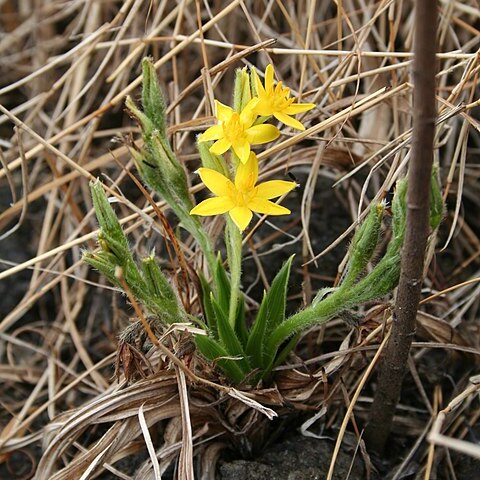Cormous perennials. Roots filamentous, fleshy-fibrous or tuberous. Leaves clustered, linear or ±terete, with short cylindrical sheath often persisting as fibrous or papery tunic. Flowers bisexual, actinomorphic, solitary, or 2-9 in corymb-like bracteolate racemes or panicles. Sepals and petals each 2 or 3, shortly connate at base, glabrous inside, glabrous or hairy outside; lobes ±elliptic, plurinerved, yellow inside, dark red to pale yellow outside or (not in Australia) white; petals shorter than sepals. Stamens 4-6; anthers dehiscing by slits, latrorse. Ovary inferior, 2-or 3-locular; ovules numerous; placentation axile; style 2-or 3-lobed. Fruit a capsule, dehiscing by transverse rupture near apex. Seeds ±rostrate, brown to black, variously sculptured, shiny or dull.
Leaves basal, sessile, linear to lanceolate, V-shaped in cross-section (conduplicate) or flat to ± terete, sometimes pseudopetiolate, sheathing at the base, pubescent along the abaxial midrib and margins, and often also on the lamina, sometimes forming a pseudostem (from the leaf sheaths and cataphylls), outermost leaves often reduced to cataphylls, new leaves produced successively from within older leaf bases the latter disintegrating into fibrous remnants; indumentum of 2-armed or 3–12-armed (stellate) hairs, white to brownish.
Fls solitary from amongst lvs, or in racemose or subumbellate infls. Per.-segs free, spreading. Stamens 6, < per.-segs; anthers ± lobed at base. Ovary not beaked; style short with erect stigmas. Fr. a capsule. Seeds ∞, small, subglobose, dark-coloured, the hardened funicle and rostrate hilum forming two conspicuous projections; testa variously muricate. Lvs grass-like, linear-lanceolate to nearly filiform, us. hairy. Some 80 spp., widespread––Africa, America, parts of Asia, Australia––but the genus sts subdivided.
Small scapose herbs from corm-like rhizomes, scatteringly pilose throughout, especially in the inflorescence; leaves narrow, grass-like, basal; inflorescence bear-ing 1 or several small yellow flowers, cymose; perianth segments 6, barely united at the base, without a tube, regular, the outer usually somewhat sepal-like; stamens 6, the filaments united to the base of the perianth; pistil 3-celled, in-ferior, more or less truncate at the tip, without a beak; fruit a capsule, dehiscing by longitudinal slits.
Fls regular, the sep and pet distinct to the summit of the inferior ovary, similar or differing slightly in size, the sep usually pilose outside; anthers basifixed, but sometimes deeply sagittate; filaments short; ovules numerous in each of the 3 locules; fr indehiscent, or a loculicidal capsule; small perennial herbs from corms or rhizomes, with grass-like, usually hairy, basal lvs and an irregular umbel of 2–6 yellow fls or a single terminal fl. 100, irregularly cosmop.
Leaves grass-like, linear-lanceolate to ± filiform, usually hairy. Flowers solitary from among leaves or in racemose or subumbellate inflorescences. Perianth-segments free, spreading. Stamens 6, < segments; anthers ± lobed at base. Ovary not beaked; style short with erect stigmas. Fruit a capsule. Seeds many, small, subglobose, dark-coloured. Spp. c. 100, Africa, America, E. Asia, Indomalesia and Australia. Adventive sp. 1.
Herbs perennial. Rhizomes subglobose or tuberous. Leaves 3--20, basal, sessile. Flowering stems shorter than leaves, slender, usually pilose. Inflorescences terminal, umbellate or racemose, few flowered or flower solitary. Perianth segments free, persistent. Stamens inserted at base of perianth segments; filament short; anther nearly basifixed. Style short; stigma 3-lobed. Fruit a capsule.
Seeds with a distinct raphe, hilum and prominent micropyle; testa shiny black or dull brownish, smooth or variously papillose; the cuticle of the papillae smooth, or with 3–4 wing-like striae radiating from the papilla apex and often with fine irregular reticulate striae between.
Hairy or glabrous herbs, bulbous or thickly rhizomatous. Leaves radical, linear to narrowly elliptical. Inflorescence a 1-to many-flowered raceme; bracts narrow. Flowers with free tepals. Stamens free. Fruit a dry capsule, regularly dehiscent.
Herbaceous geophytes; perennating organ a vertical rhizome surmounted by a ± dense coat of fibrous leaf remnants and ringed by stout contractile roots usually arranged in an equatorial zone on the rhizome.
Inflorescences usually produced continuously throughout the season; scapes simple or branched; flowers racemosely or corymbosely arranged, or flowers solitary; bracts hairy along the keel and margins.
Perianth segments (tepals) free, acute to obtuse, persistent, yellow adaxially; outer tepals greenish and pubescent abaxially, inner tepals yellowish-green and pubescent only on the abaxial midrib.
Stamens 6, uniseriate; filaments short; anthers latrorse, thecae fused or free at the apex.
Ovary 3-locular; fruit a capsule with circumscissile or loculicidal dehiscence.

